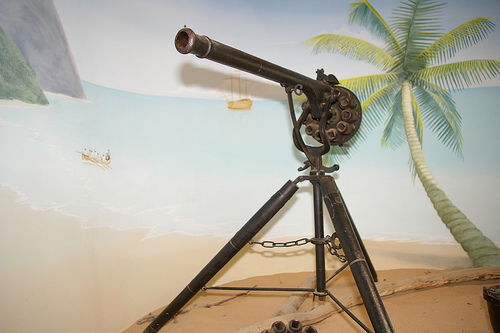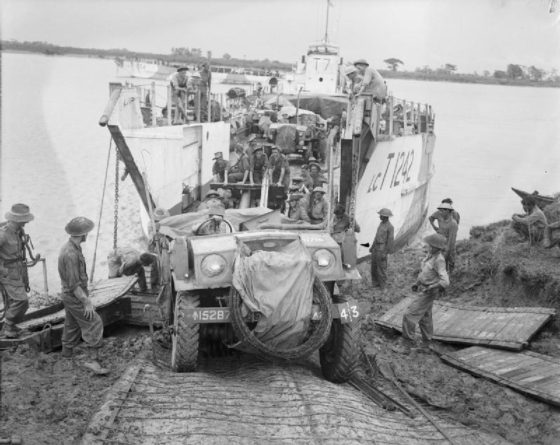
“While the Gatling gun may be the best-known early-machine gun, the mechanical marvel was by no means the first attempt to fire lethal projectiles in volleys or in rapid succession.”
ONE OF THE GREAT ironies of history is that the inventor of the first modern machine gun, Dr. Richard Gatling, devised his famous rapid-fire weapon because he wanted to prevent human suffering.
The North Carolina-born physician recognized that the mass armies of the 19th Century were ideal breeding grounds for infectious diseases. As such, far more soldiers perished in overcrowded and unsanitary army camps than ever died on the battlefield. By inventing a weapon that put the firepower of an entire regiment into the hands of individual infantrymen, Gatling hoped that the commanders of the future could march off to war with much smaller armies — tens of thousands, perhaps even millions, would be spared from the health risks long associated with military campaigning. It didn’t work out that way.
While Gatling’s 1861 hand-cranked, six barreled, rotary gun could spit out 200-rounds a minute, it didn’t make armies any smaller. But it certainly made the battlefield deadlier. In fact, the weapon, which made its combat debut in the Civil War, was so effective at mowing down enemy troops, armies and navies throughout Europe and the Americas snapped them up as quickly as they could. In the decades that followed its invention, Gatling guns were used against North American Indians, Chinese nationalists, African tribesmen and samurai warriors. While the Gatling gun may be the best-known early-machine gun, the mechanical marvel was by no means the first attempt to fire lethal projectiles in volleys or in rapid succession. Several ingenious inventors, some going back centuries, had already attempted (and not without some degree of success) to create rapid-fire weapons. Here are some of their innovations.

Mitrailleuse – 1851
Before the Gatling gun, there was the mitrailleuse or “grapeshot shooter”. The first mitrailleuse, developed by the Belgians in 1851, was a 50-barrel, rapid-fire weapon was capable of shooting up to 100 rounds a minute. A gun crew would load each barrel with a single rifle round. When ready for action, a hand crank at the breech could fire off the barrels in rapid succession or several at once. Improvements were made to the design throughout the 1850s by two engineers named Joseph Montigny and Louis Christophe. Montigny eventually sold an upgraded 37-barrel version of the weapon to Napoleon III of France.

A French gunsmith named Jean-Baptiste Verchère de Reffye further modified the design. Impressed with the battlefield potential of the new contraption, the emperor ultimately manufactured 200 of them. The mitrailleuse was kept top secret until the Franco Prussian War in 1870 when it was deployed on the battlefield for the first time. Embedded with the artillery, the weapons were kept in the rear, far out of enemy rifle range. As such, the six-man crews had little chance of hitting anything with their newfangled guns. Worse, the weapons, which used conventional black powder, were prone to fouling after repeated firing. Yet, on the rare occasions when the French deployed the mitrailleuse close to the action, they were devastating. Despite Prussian propaganda that scoffed at the supposed uselessness of the mitrailleuse, the weapon did make quite an impression on the German infantrymen — they called it the “Hell Machine”. Ironically, by the time of its first use in combat, the mitrailleuse had already been rendered obsolete by more effective weapons like the Gatling gun. And by the end of the following decade, the Gardner and Maxim guns (the first true machine guns) would be in use. However, to this day, the French word for “machine gun” is mitrailleuse.

Nock Gun – 1779
While more of a volley weapon than a machine gun, Britain’s Royal Navy hoped the multi-barreled Nock gun would be a serious force multiplier in ship-to-ship boarding actions. The weapon featured seven rifled barrels, each with a tiny vent that led to the priming pan. The barrels would be loaded with standard paper musket cartridges. When the main charge was ignited, sparks would shoot through the vents and set off each of the cartridges at almost the same instant. Developers imagined the Nock would be particularly deadly when used against groups of tightly packed enemy sailors on the deck of a warship. Unfortunately, the weapon suffered from some major flaws: not only was the recoil too powerful for a typical sailor or marine (especially when used by marines balancing aloft in a ship’s rigging), but the flaming remnants of paper cartridges that were belched out of the gun’s seven barrels were a tremendous fire hazard aboard a wooden ship with canvas sails. Also, since rifled muskets in the 18th Century were much slower to load than the smooth bore weapons of the day, the Nock could take nearly 10 minutes reload, effectively putting a sailor or marine out of action. Attempts were made to develop an easier to load, non-rifled version, but the recoil was still too powerful to make the gun practical. While the Navy ordered nearly 700 of the weapons, they were retired from service in 1804.

Puckle Gun – 1718
The brainchild of an English inventor and lawyer by the name of James Puckle, the gun that bore his name was essentially an over-sized, hand-cranked revolver – invented more than 120 years before Samuel Colt’s legendary six-shooter. The weapon, also known as a defense gun, had a single barrel, behind which sat a large 11-chamber cylinder, each loaded with a 32 mm ball (about twice the diameter of a musket round) with a powder charge. Originally intended to be mounted on the sides of warships and fired directly at the deck crews of enemy vessels, the gun could loose about 10 rounds a minute — roughly three times the rate of fire of a musket of the time. Puckle designed two versions – one that fired conventional round shot and another variant launched square bullets. Considered much more lethal than ball shot, these block-shaped rounds were only to be used against Muslim Turks and other non-Christian enemies. While investors had high hopes for the Puckle gun’s popularity, the British military remained unimpressed. The complexity of its design made it impractical, especially in the era before interchangeable parts. Does this mean the gun was ahead of its time? Perhaps. But contemporaries pointed out that the only people ever harmed by the Puckle Gun were its investors.

Ribauldequin – 14th Century
The ribauldequin was the earliest attempt at a volley gun. Also known as an “infernal machine” or an “organ gun” (because its barrels resembled the pipes of a church organ), ribauldequins were made up of many small caliber cannons laid side by side on a flat platform. When the gun was fired, it would spread a volley of cannon shot across the battlefield, chewing up everything in its path. The ribauldequin made its battlefield debut with the armies of Edward the III of England during the Hundred Years War. This first model, which appeared in 1339, featured 12 barrels. In subsequent decades, other versions of the ribauldequin with more barrels were used by medieval armies in Italy as well as in the War of the Roses.

Repeating Crossbow – 4th Century BC
Even before gunpowder, armies have tried to come up with weapons that could hurl projectiles in rapid succession. As early as the 4th Century BCE, Chinese inventors experimented with crossbows that could fire several bolts in a single volley or could be reloaded automatically from a hopper or magazine of bolts each time the bow string was drawn back. Known as ‘continuous crossbows’ the weapons are believed to be first pioneered by the Chinese warlord and strategist Zhuge Liang. Although able to fire much more rapidly than a conventional crossbow (about 10 bolts in 15 seconds), these rapid-fire weapons didn’t fire projectiles with the same force as their conventional cousins — to make them extra lethal, Chinese crossbowmen would dip their bolts in poison. Crossbows like this continued to be used throughout the Far East until the late 19th Century. The Chinese weren’t the only civilization to experiment with rapid-fire bow weapons. The Ancient Greeks had developed a mechanical, chain-driven ballista that could automatically load and fire bolts in rapid succession. The polybolos as it was known, was supposedly invented by Dionysius in the 3rd Century BCE.
(First published on June 25, 2012.)










Fascinating information in this post. I had no idea the French had come up with one – although it was useless unlike their wine. 🙂
Ha. I didn’t know this either until I started reseaching.Thanks for the post.
Great information! Never knew about the continious crossbow… I thought that was a Hollywood invention for van Helsing! 😮
Never saw the movie. 🙂
You did not miss much! 😉
I thought the Qing Dynasty of China invented one too?
Rapid fire gun was never a term until leftist in the past few years. This is an indoctrination term used to label any gun to them that now fires as fast as they deem horrible
Although some people like to make *everything* about partisan politics, in this case, the term ‘rapid fire’ was chosen because it would simply be wrong to refer to pre-Gatling weapons as ‘machine guns.’ The term doesn’t come up until the 1880s.
Really? Machine gun came up here in 1722 bill of lading. http://eprints.hud.ac.uk/id/eprint/17394/1/BUCCLEUCH_PROJECT_Royal_Armouries_version_2_5_FinalProofEDIT.pdf
these guns were a forerunner of the machine gun and were
fed by drum-magazines….the Puckle Gun wasn’t a machine gun
“Rapid-fire gun” appears at least as early as 1861.
who ever wrote this is an idiot because the puckle machine gun was made in 1718